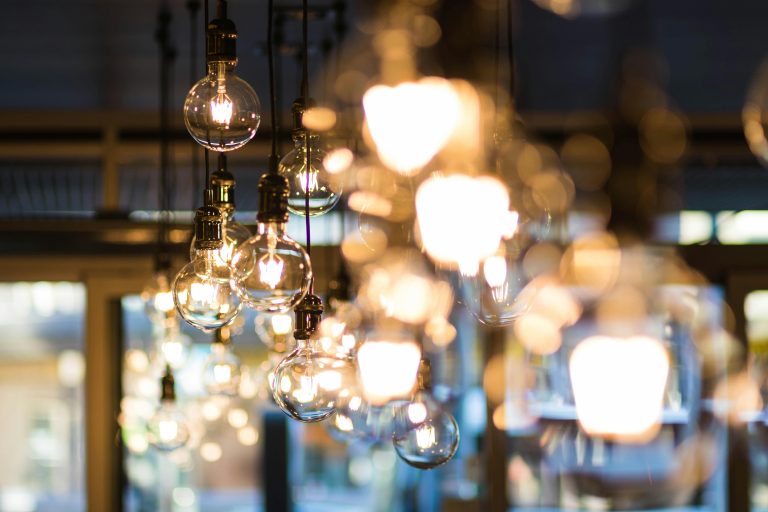Lighting is not just functional, but it creates a visual rhythm in a space. Glass, aluminium, brass and bronze are some of the materials that create tone and contrast in interiors when selected properly. Although the temptation of most homeowners is to stick to homogeneity, a mixture of diverse finishes creates richness and depth. An example is bronze lights, which create a warm contrast to the cooler things, incorporating character into both classic and modern environments.
Bronze for Earthy Elegance
Bronze is one of the metal finishes that has a touch of time-worn, which gives a grounding energy to any space. It has a low-key luminosity that goes well with wood tones, stone surfaces and natural textures, and so it is especially useful in rooms with organic palettes. Bronze looks great in pendant groups over dining tables or at entryway lanterns, where the deep undertones make a low-key, high-impact statement.
Use bronze to complement, not compete, with other materials when mixing it with other materials. Bronze can also contrast with polished metals or reflective glass. That visual conflict creates harmony instead of chaos.
Aluminium’s Lightweight Edge
Minimal and streamlined, aluminium brings a technical edge that can be perfectly applied in contemporary or industrial settings. Its dull silver colour blends with cool colours: slate, concrete or marble, and balances with warmer metals.
Aluminium task lighting is sharp and clean in kitchens and work areas. When paired with a bronze chandelier in the same room, it creates a contrast in narratives, where form meets comfort and accuracy meets ambience. Seek matte finishes to eliminate unwanted glare and facilitate the smooth blending of various textures.
Glass as a Balancing Agent
It is due to translucency that glass is an excellent mediator between materials. It is ribbed, frosted or coloured to reflect light, but not to dominate other finishes that are near it. Metal is softened by wall stubs or floor lamps with glass diffusers so that the light is distributed through the room.
Glass is also adaptive to the materials around it. It is luxurious and framed in brass. It is modern and clean in its reading, housed in an aluminium casing. Combined with bronze lights, it makes them lighter and adds a charming balance to the composition.
Brass for Refined Warmth
The golden feeling of brass feels vintage and customised. Its gentle glaze adds a retro feel but does not go anywhere near overdoing it. Brass table lamps or swing-arm lamps in the living rooms or bedrooms add character without asking to take centre stage.
In incorporating brass as a part of a multi-material scheme, use diverse finishes, such as brushed, antiqued, or unlacquered, to bring in some shades. Incorporate neutral upholstery and mid-tone woods to avoid the use of visual heaviness. Bronze has to be used with brass, which must be done selectively; proportion, not monotony, is the rule.
Keep Room Function and Style in Sync
Every room should also have its own palette, which is determined by the utilisation of the space. The mixing of aluminium and glass in social spaces, such as the kitchen or dining room, promotes the impression of clean but layered design. Brass and bronze are used to great advantage in living areas, where texture and depth create a sense of comfort and ease.
Select anchor ones which are normally fixtures on ceilings and then add accents. Not everything should be in harmony. Echo texture or tone rather than reflection finish. This is permissive in the visual aspect.
Tying It Together with Colour and Shape
The same pairings of colours coordinate different materials. If your room is heading towards a warm tone, use brass and bronze colours to reinforce it. In cooler schemes, use aluminium and clear glass. However, take care of shape – repetition of curves, lines, or angles will produce harmony even though the finishes are different.
An illustration is the shape of a bronze round pendant of a dining table reflecting the shape of a brushed aluminium floor lamp next to the table. In a like manner, a ribbed glass sconce can have visual rhythm with a panelled brass lantern, despite differing in their finishing.
Contrast Creates Cohesion
Matching lighting materials is not as much about telling a story as it is about creating a specific atmosphere. Even the finish, in the form of bronze lights, aluminium or brass detailing, or glass detailing, or any other detail, adds a chapter to the story in the room. These materials are good when creatively blended together. Lighting is more than a means of functionality through contrast, repetition, tone and silhouette. It is that string that ties your design into a meaningful whole.


